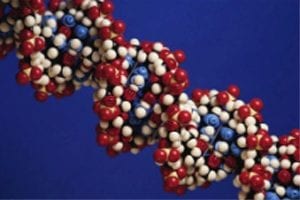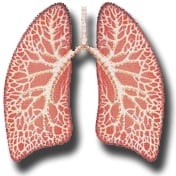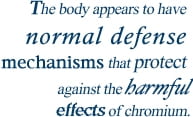What Charge Does Chromium Have
What is Chromium?

Chromium, a "transition" metal, is of intermediate atomic weight – that is, it is non considered either a heavy metallic or a light metallic. Information technology is found primarily in three chemic states depending on its electrical accuse. Common forms are chromium-0, which has no charge, chromium+3, which has an ionic charge of plus 3, and chromium+6, which has a accuse of plus 6.
Chrome metallic (the form chromium-0) is the chemical element that makes steel "stainless." Chromium in this class is hard, stable, and resistant to chemical changes such as oxidation or rust. Steel alloyed with chromium is harder and less brittle than iron and highly rust-resistant. This form of chromium is as well used to coat or "chrome plate" the surface of other metals to produce a hard, shiny, chemically resistant surface.
The primary form of chromium found in the environment is chromium+3, which is also quite stable. This mutual form of chromium is always found in a circuitous with other chemic partners such every bit oxygen or chlorine. In these compounds it is very "inert to substitution", that is, information technology is resistant to changing its grade or exchanging its chemical partners.
Though pocket-size quantities of chromium+6 are found in nature, virtually of the chromium in this course is man-made. Chromium+6 is easily and apace reduced to chromium+3 by many chemicals and conditions, then information technology is not very stable in the environment. Similar chromium+3, chromium+six is usually found in chemical complexes with other elements, for example bound with several oxygen atoms to class chromate. It is very difficult to oxidize chromium+iii to chromium+vi, though information technology tin be done with strong oxidizing agents and very high temperatures. An industrial process called "roasting" is used to oxidize the chromium+iii derived from ores into chromium+6, a class used in a wide diverseness of commercial products.
Where is Chromium Found?
Chromium is widely dispersed in the environs. In the Earth's chaff chromium is present at an average of 140 parts per 1000000 (ppm), just is not distributed evenly. High concentrations of chromium tin can be found in certain ores, which are mined commercially.
At that place are trace amounts of chromium in rocks and soil, in fresh water and bounding main water, in the food we consume and drink and in the air nosotros breathe. Levels of chromium in the air are by and large higher in urban areas and in places where chromium wastes or "slag" from production facilities were used as landfill.
Chromium wastes have been detected in many landfills and toxic waste sites across the country, usually in combination with other metals and chemicals. In the Aberjona River watershed near Boston Massachusetts, industrial wastes containing chromium contaminated the river and swimming sediments. In some areas the sediments contain as much as one to two per centum chromium by weight. However, contempo studies suggest that people living nearby have received very little exposure to the chromium from these sediments. The principal touch is ecological in areas such equally this, where concentrations of several toxic materials collectively threaten aquatic nutrient webs and the wildlife they support.
What are the Uses of Chromium?

Chromium is used in paints, dyes, stains, wood preservatives, curing compounds, rust inhibitors and many other products. Notwithstanding, the predominant use of chromium is for production of stainless steel and in chrome plating. A radioactive form of chromium is used in medicine to tag, or label, red blood cells inside the human being body. The labeling is permanent for the lifetime of that jail cell, and then it is a useful way to look at long-term patterns of blood prison cell turnover in the body, to look for evidence of internal bleeding and for similar studies.
Considering of commercial demand, chromium-containing ores accept been mined and processed intensively over the past century, and many industries manufacture or utilise chromium containing compounds.
Do we Need Chromium for Health?
Humans need chromium, in the course of chromium+3, for proper health. However, most people get all the daily chromium they need from a normal, well-balanced diet.
Nutritionists have learned over the past century that certain substances, such as vitamins and minerals, are essential to normal performance and health. These substances are not made in the body, so they must come from foods. (The British Navy discovered this connection in the 1700s, when they observed that sailors on long sea voyages often developed a condition chosen scurvy. Calculation citrus fruits such every bit limes to the sailors' diets prevented the condition. This is how English language sailors first came to be known every bit "Limeys.") Since chromium is nowadays in all foods, and is especially loftier in sure plants, few people are deficient in dietary chromium.

The Federal authorities establishes guidelines for "Essential, Safe and Acceptable Daily Dietary Intake" or ESADDI (formerly called the Recommended Daily Allowance or RDA) of an essential vitamin or mineral. For chromium, the recommended ESADDI level is l-200 micrograms per day of chromium. Chromium is a standard component of most multi-vitamin/multi-mineral pills and food supplements. Chromium is also present in all foods and is especially high in certain plants. U.S. Department of Agriculture scientists recently suggested, based on their own studies, that certain people such as the elderly, diabetics, and others with blood carbohydrate (glucose) regulation problems can benefit from even higher levels of chromium, perhaps as high equally 500-800 micrograms per twenty-four hour period, which would commonly crave a supplement tablet. More than controversial is whether the general public needs more chromium than they get from their diet. Several manufacturers of over-the-counter chromium supplements accept claimed that high doses of chromium are benign for dieting and bodybuilding, merely the majority of controlled, independent studies to date fail to show whatsoever benefit from chromium supplementation for normal individuals. On the other hand, there is currently no evidence that taking chromium supplements is necessarily bad for you, since chromium+3 is not very toxic even at relatively high doses.
How does Chromium Deed as a Food?
The best known nutritional effect of chromium is that it appears to assist insulin in regulating blood sugar (glucose) levels. Insulin is a small protein hormone that is released into the blood when blood glucose levels get too high. Insulin then binds to a receptor on the outside of cells, causing them to blot more glucose from claret, returning blood glucose levels to normal. If glucose levels fall too low, other signals in the body prompt cells to release glucose to the blood. This "seesaw" glucose regulation is disrupted in people with diabetes, unremarkably due to a lack of insulin product or a failure of cells to properly respond to insulin. Chromium appears to enhance the effects of insulin once insulin binds to its receptor.
Human bodies do not appear to store or absorb chromium+3 very well, taking upward only 1 or 2 percent of the total chromium available in the intestines from food. But humans do have a fashion to take upwardly more chromium when it is needed – the lower the body'south level of chromium, the more efficiently it is taken up from the intestines. Chromium+3 does not easily cross cell membranes, and it appears to interact with cells only when needed, which suggests that it is stored in a form the body can rapidly mobilize, either in blood or nearby where blood can easily draw on it.
The form of chromium associated with enhancing insulin's effect is a complex of several chromium+3 atoms spring together with amino acids. The response of cells to insulin is much greater in the presence of this LMWCr complex (also called chromodulin). The complex appears to be different from the storage grade of chromium in the claret, which is not still well defined.
Recently, Dartmouth toxicologist, Joshua Hamilton and his colleagues discovered that chromium also affects the other side of the "seesaw" that controls blood glucose levels, increasing cell signals that showtime the effects of insulin. This appears to be through interaction with another equally yet unknown poly peptide receptor on the surface of cells. The mechanism for this effect and the identity of this new receptor are intriguing research questions that remain to be answered. In that location may also be other uses of chromium by the body that remain to be discovered.
Is Chromium Harmful to Humans?
The about common health effect from exposure to chromium is contact dermatitis – skin inflammation or rash. A small fraction of the population, between 5 and 10 pct, has an allergic skin reaction to chromium. Much like other allergies – to foods, bee stings, cotton fiber, wool – this allergic response is genetically based. When genetically predisposed individuals are exposed to chromium compounds their skin can become reddened and swollen; the status clears up once exposure stops.
Fugitive skin contact with chromium – in jewelry for instance – is not a trouble for virtually of the general population but those whose occupations involve daily exposure to chromium compounds, such equally cement workers, may develop chronic allergic reactions that necessitate irresolute or modifying their jobs. In the past, workers in the chrome ore industry who were contact-sensitive could develop a related asthma-like condition in the lungs and respiratory tract if they suddenly breathed in large amounts of chromium-containing dusts. These incidents are rare now due to modernistic occupational safety and wellness practices.
Is Chromium in the Workplace a Health Run a risk?

Until safer workplace practices were adopted in the 1960s, large numbers of workers were exposed to high levels of chromium+3 and chromium+6 over periods of 30 to 50 years. Studies in the 1930s and others conducted later on Globe War 2 institute higher rates of respiratory cancers in these workers. A complicating factor in the post-war studies is that those workers- unlike the workers of the 1930s – included a very big fraction of lifelong cigarette smokers. That made information technology more than difficult to determine whether information technology was exposure to cigarette smoke or to chromium that was related to higher rates of lung cancer. Analysis of the workplace studies indicates that prior to the 1960s workers exposed to high levels of chromium had four times the take a chance of developing lung cancer compared to unexposed people. Past comparison, cigarette smoking is estimated to increase a person'due south risk of lung cancer 10 to twenty times.
Cigarette smoking has been shown to synergistically increase the risk of lung cancer for people exposed to certain metals, such as arsenic, cadmium and nickel equally well as other chemicals. That is, the risk of lung cancer in a smoker exposed to one of these agents is much college than what would exist predicted past simply adding the two individual risks together. But recent studies suggest that, unlike the case with these and many other lung carcinogen combinations, chromium and cigarette smoking exercise non act synergistically with each other. The reason for this is not clear, only this supports the idea that chromium is a relatively weak carcinogen fifty-fifty at very high occupational doses.
Recent studies bespeak that people who began working in chromium industries from the 1960s on under more modern occupational hygiene atmospheric condition accept levels of respiratory cancer that are not significantly different than the full general population.
Is Chromium in the Environment a Health Hazard?
While industrial hygiene practices take largely reduced or eliminated health risks from exposure to chromium+6 dusts, there is growing concern about environmental exposures. For example, there are sites in the U.S. where big amounts of chromium-containing wastes have been dumped or used as landfill, such as in areas of northern New Jersey in the United States. This led to concern over whether expanse residents were at take chances of illness from inhaling chromium-contaminated dusts from these sites. However, studies comparing the health of residents well-nigh these sites to other populations accept found no significant differences. Under these weather condition, levels of exposure to chromium are likely to exist below those of concern. Notwithstanding, the issue is notwithstanding under active investigation.
Concerns accept likewise been raised about possible health effects of chromium-contaminated drinking water. However, there is no prove to date of a link between chromium exposure from drinking water and whatsoever human being health effects. Even under the higher occupational exposures of the past at that place is no evidence for whatsoever cancers in humans other than respiratory cancers, nor is in that location evidence of cancer from exposures other than long-term inhalation of chromium+half dozen dusts. In fact, on a gram-for-gram ground, chromium is not considered especially toxic every bit compared to other metals, even by ingestion. Chromium+3 has nigh the aforementioned relative toxicity as table salt in lab animals. Chromium+6 is about twenty times more toxic, but is still hundreds or thousands of times less toxic than other metals such every bit cadmium or mercury.
Can Chromium Crusade Cancer?
Shortly after studies showing that workplace exposure to chromium+6 increased the risk of lung cancer, researchers began to examine how chromium behaves in the human trunk. In experiments using jail cell cultures, investigators found that chromium+6 crosses cell membranes and gets into the prison cell much more easily than chromium+three, which does not normally get into cells. One time inside cells, chromium+6 can damage Deoxyribonucleic acid, the hereditary cloth of the jail cell, and this damage can lead to mutations. Mutations in certain cancer-associated genes of the prison cell are believed to be the basis for initiating cancer.

Scientists found that treating cells with chromium+3 did not crusade Deoxyribonucleic acid impairment or mutations, which was non surprising since chromium+three did not enter the cell. When cells were treated with chromium+6, chromium was plant attached to the Dna molecule in diverse ways to cause harm. Surprisingly, the form of chromium attached to the Deoxyribonucleic acid was chromium+3, not chromium+6. How to explain this apparent paradox?
The solution to this puzzle was proposed by Dartmouth chemist Karen Wetterhahn and her colleagues in what became known as the "uptake-reduction model" of chromium toxicity. The researchers found that chromium+half-dozen could rapidly be reduced past several small molecules within the cell to form chromium+iii. During metabolism, chromium passes through several forms that are highly reactive and unstable. In addition, the procedure of chromium reduction can create reactive oxygen and other free radicals inside the cell. This combination of reactive intermediates was postulated to be able to attack DNA, leading to the Dna damage and the chromium binding that was observed. Since they are unstable, these intermediates are reduced to the stable chromium+3 found on the DNA at the end of the procedure. So although chromium+3 remains outside the cell, chromium+half-dozen is taken upward and is eventually reduced to chromium+iii within the cell.
The Wetterhahn uptake-reduction model has served equally the cardinal paradigm for the chromium field for the past xx years, and fix the stage for a more complete understanding of how chromium behaves in the torso. Wetterhahn and other researchers besides plant that chromium+6 could too exist reduced to chromium+iii by serum components and other chemicals of the claret exterior the jail cell. In cell culture, serum is normally added to assist feed cells. Notwithstanding, treatment of cells with chromium+6 in the presence of serum caused a reduction of the chromium outside the cells rather than inside. This meant no uptake of the chromium, and no Deoxyribonucleic acid damage or mutations. And then components of the blood appeared to protect the cell from chromium+half-dozen uptake.

Recent studies have chosen into question the idea that the 0primary way chromium+6 causes cancer is past damaging Dna and causing mutations. Showtime, to produce a relatively modest number of mutations researchers needed to use chromium levels that are hundreds or thousands of times college than the levels required by other agents. 2nd, there appears to exist a long latency time for the development of cancer in chromium-exposed workers, requiring as much as xxx to 40 years of exposure. Information technology also appears that continuous exposure is required, since shorter or disrupted occupational exposures did non significantly increase cancer risk. These observations suggest that chromium might be interim past a mechanism other than, or in improver to causing mutations.
Some other class of chemicals that can increase cancer take chances slightly without causing mutations are tumor promoters. These agents button a cell forth the path of cancer evolution past acting on mutations caused past other events. To effect cancer rates, tumor promoters also require a constant rather than single or curt duration exposure. Is chromium+6 interim equally a tumor promoter? It has recently been shown that treating cells with chromium causes sure cell signaling changes that are more like to the effects of tumor promoters than to the furnishings of mutagens. These prison cell signaling events in plow lead to changes in cistron expression . These alterations occur fifty-fifty in the absence of Dna impairment, and at lower doses, suggesting that this may be a more important mechanism in humans. Still, this idea will crave further investigation, and it may be that chromium contributes to cancer risk by both mechanisms.
Why is Chromium Associated with Lung Cancer?

There are many agents that testify a similar pattern of causing respiratory diseases, such every bit asbestos, fine wood dust from manufacturing piece of furniture, grain elevator grit, coal grit from mining, and fibers or dust in cotton fiber mills and ceramics factories. These agents all share some common characteristics. All are inhaled as dusts, tiny fibers or fine particles with a particular size and shape that allows them to penetrate into the deep recesses of the lung. Once there, they are cleared poorly by the lung, and almost do not dissolve or break downwardly readily inside the lung. This leads to a long "residence time." In continuous exposures such every bit workplace settings, a large build-up of these particles can occur over time. Common effects of these agents are chronic lung inflammation, or fibrotic illness and certain cancer.
The increased risk of lung cancer associated with chromium+half-dozen has been shown to require long-term inhalation of loftier levels of chromium-laden dusts. Chromium+half dozen compounds with intermediate solubility in water are also near closely associated with lung cancer. This may be considering highly insoluble forms volition not readily release their chromium+6 to cells, whereas forms that are highly soluble dissolve quickly in the lung, where chromium+half-dozen is rapidly and thoroughly reduced by the extracellular lung fluids. However, the intermediate soluble forms can sit in a higher place a jail cell and slowly dissolve over time.
If this process occurs throughout the lung for 30 or 40 years, it may well overwhelm the natural defenses of the lung and contribute to increased cancer take a chance.
How do our Bodies Protect united states of america from the Harmful Effects of Chromium?
The trunk appears to accept normal defense mechanisms that protect against the harmful effects of chromium. In improver to work past Karen Wetterhahn, Silvio DeFlora and his colleagues demonstrated that many of the other fluids of the body have very high levels of chromium reducing chemicals, resulting in a big chapters to reduce chromium+6 outside the cells of the body. These fluids include saliva, breadbasket and intestinal fluids, lung fluids, fungus, blood, and the layers of the peel. All these protective mechanisms reduce chromium+6 on the outside of cells, preventing its uptake. It has besides been proposed that reduction of chromium+half-dozen in the intestines, in the presence of amino acids, leads to formation of the natural form of chromium+iii that the body uses, which may lead to enhanced uptake of this form. Human volunteers who drank a large glass of concentrated chromium+6 had very piddling uptake of total chromium, and the simply course that was observed in the body was chromium+3. Studies with homo volunteers also showed that exposure of the skin to chromium+half-dozen-containing h2o in a bathroom or shower resulted in footling or no uptake of chromium.
 Laboratory brute studies have also been performed to determine the effects of chromium+vi under controlled weather condition. Exposure of animals to very high doses of chromium+six in drinking water resulted in no measurable wellness effects, fifty-fifty at extremely high doses given for the lifetime of the animals. This confirmed what had been observed in humans following ingestion.
Laboratory brute studies have also been performed to determine the effects of chromium+vi under controlled weather condition. Exposure of animals to very high doses of chromium+six in drinking water resulted in no measurable wellness effects, fifty-fifty at extremely high doses given for the lifetime of the animals. This confirmed what had been observed in humans following ingestion.
Information technology was initially very difficult to show that chromium is a carcinogen using animals. Initial experiments did not bear witness whatever differences between command and chromium-exposed animals even at very loftier doses given for the lifetime of the animals, using a variety of chromium compounds and normal means of exposure. Eventually, experiments were able to evidence that chromium can elevate cancer rates in animals. Nevertheless, to accomplish these researchers had to use extremely high doses, use solid or other non-dissolved forms of chromium compounds, and betrayal the animals to these agents in ways that got around the normal protective mechanisms of the torso. For case, animals were injected with a large slurry of chromium straight into the musculus, or were exposed past surgically implanting a large "cage" of solid chromium directly into the respiratory tract of the brute. These studies reinforce the idea that chromium+6 is at best a weak carcinogen, and only with sure forms and past certain ways of exposure. They likewise demonstrate that the body unremarkably has substantial barriers to the effects of chromium+6 exposure, which must be overwhelmed before an outcome is seen.
Although the human being and animal evidence to date suggests that there are no adverse health effects of chromium in drinking water, there have been just a few long-term beast studies that specifically examined this issue in the laboratory. Considering of recent concern virtually chromium in drinking water, the State of California recently petitioned the National Toxicology Programme, which is overseen past the National Institute of Health's National Constitute of Ecology Health Sciences, to do a long-term study every bit part of their ongoing assessment of ecology chemicals of concern. This study is examining furnishings of lifetime chromium+6 exposure in drinking water in several animal species under controlled conditions that are designed to dominion out other factors. The concluding results of these studies will become available in ii to 3 years.
What Charge Does Chromium Have,
Source: https://sites.dartmouth.edu/toxmetal/more-metals/chromium-a-thoroughly-modern-metal/the-facts-on-chromium/
Posted by: kingrepasustem.blogspot.com


0 Response to "What Charge Does Chromium Have"
Post a Comment